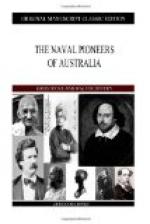It is still often written that the “open bay” was so named after a seaman by the name of Jackson on board the ship; but Sir George Jackson, who afterwards changed his name to Duckett, was at this time, with Mr. Philip Stephens, joint secretary to the Admiralty. Cook named Port Jackson and Port Stephens after these two officials, and there was no seaman named Jackson on board the Endeavour. Cook did not enter Port Jackson, and the discovery of the finest harbour in the world was left for another less well remembered, but no less efficient and zealous, naval officer.
The simple entries in the Endeavour’s logbooks, to the sailor who reads them, tell far better than the fine writing of Dr. Hawkesworth the difficulties which Cook laboured under on this voyage. For example, His Majesty’s ship Endeavour was so well found that on April 14th, 1770, Cook has this entry:—
“The spritsail topsail being wore to rags, it was condemned as unfit for its proper use, and taken to repair the topgall’ntsails, they being so bad as not to be worth the expense of new canvas, but, with the help of this sail, will be made to last some time; also took out one of the ship’s tents (50) yards of canvas to repair the jibb that was split on the 1st instant, there being neither new canvas nor twine in the ship to spare for that purpose.”
But the most serious trouble was when on the 11th of June the Endeavour got ashore on the Barrier Reef. Here is Cook’s entry:—
“Shoal’d the water from 20 to 17 faths., and before the man in the chains could have another cast the ship struck and lay fast on some rocks, upon which we took in all sail, hoisted out the boats, and sounded round the ship, and found that we had got upon the edge of a reef of coral rocks, which lay to the N.W. of us, having in some places round the ship 3 or 4 fathoms, and in others about as many feet; but about 100 feet from her starboard side, she laying with her head to the N.E., were 7, 8, and 10 fathom. Carried out the stream anchor and two hawsers on the starboard bow and the coasting anchor and cable upon the starboard quarters, got down yards and topmasts, and hove taught upon the hawser and cable; but as we had gone ashore about high water, the ship by this time was quite fast. Turned all hands to lighten the ship, and in order to do this we not only started water, but hove overboard guns, iron and stone ballast, casks, hoops, staves, oyl-jars, stores, and whatever was of weight or in the way at coming at heavy articles. All this time the ship made but little water. Being now high water, as we thought, hove a strain upon the stern anchor, as I found the ship must go off that way, if at all, but all we could do was to no purpose, she not being afloat by a foot or more, notwithstanding we had hove overboard 40 or 50-ton weight; but as this was not sufficient, we continued to lighten her by every method we could think of. By that time she begun to make water as much as two pumps could free. At noon she lay with three streaks heel to starboard. Lat obs’ed, 15 degrees 45 So.”
This was off what Cook called Cape Tribulation, and on the two following days these entries appear:—




